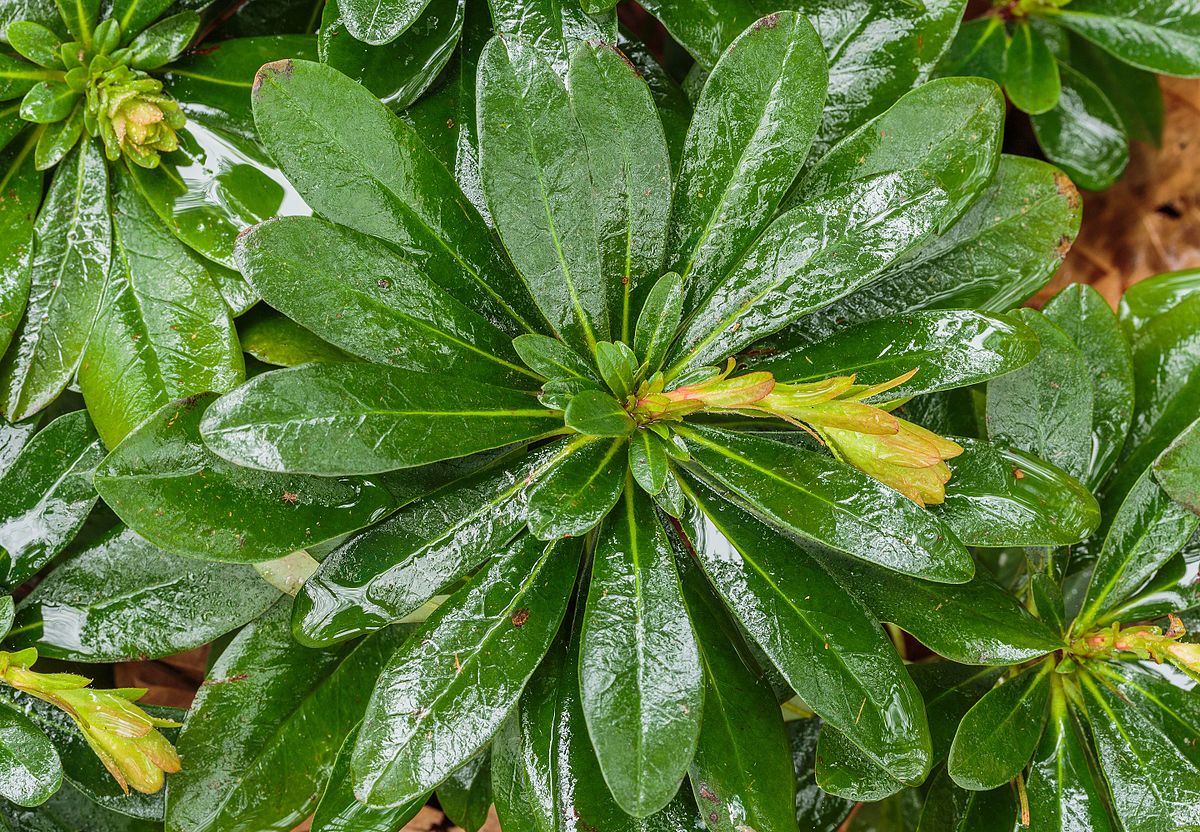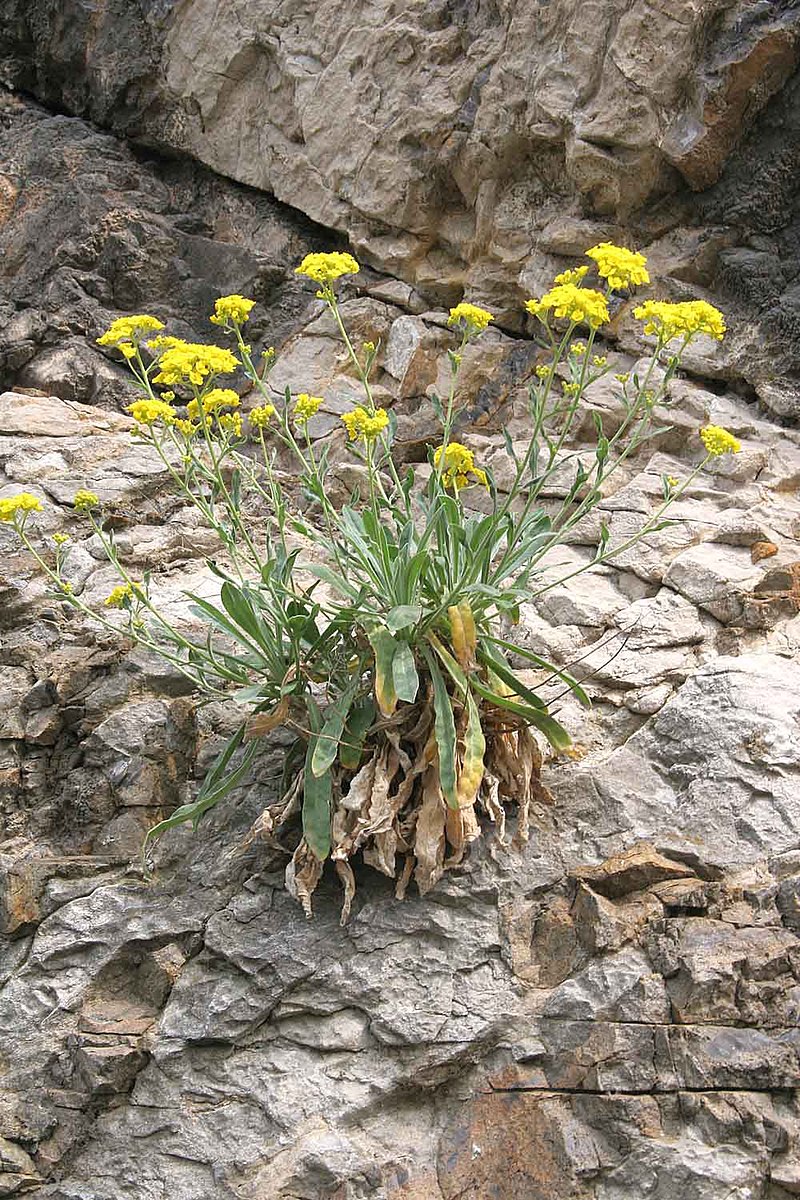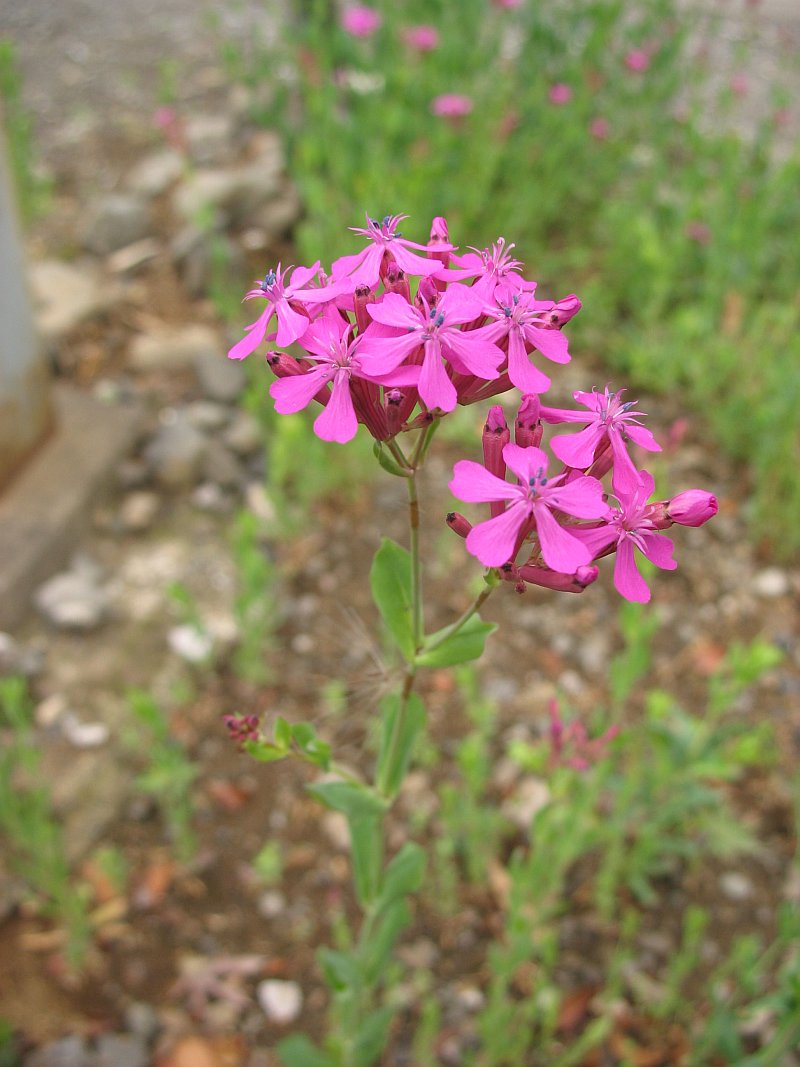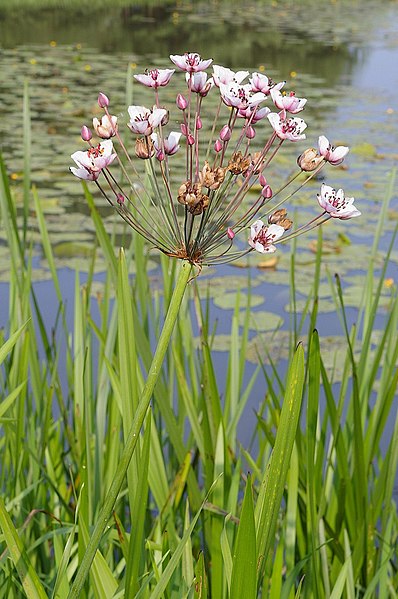The following photograph, showing the plant in typical habitat, is by Stefan Lefnaer as published on Wikimedia Commons.
I am the Botanical Society of Britain and Ireland (BSBI) Vice-County Recorder for Huntingdonshire (VC31) and Mid-West Yorkshire (VC64). I've set-up this botany blog to more readily share news on recent wildflower discoveries made by myself and others, to encourage wider recording, and as a way to challenge myself to take more photographs of the plants I find. See the BSBI website for more information on the work of the society and the diverse range of botany projects currently in progress.
Showing posts with label Euphorbia. Show all posts
Showing posts with label Euphorbia. Show all posts
Monday, 13 August 2018
Spotted Spurge New for VC31
Its good to have some news from Huntingdonshire. Alan Leslie sends details of Spotted Spurge (Euphorbia maculata) found growing in the corner of the car park at Waresley garden centre in the far south of the county. This is a species that seems to be on the spread, particularly in urban habitats. One to look out for over coming years.
Saturday, 18 November 2017
VC64 End of Season Update
I have just finished crunching an excellent and large batch of records from Bruce Brown, who has been really active for the New Atlas in SE04, 05 and 06 over the summer. I'm looking forward to seeing what his efforts do for the stats on these hectads.
My personal choice of highlights include, starting with the natives:
The under-recorded reservoir drawdown specialist of 'Intermediate' Plantain (Plantago major subsp. intermedia) at Embsay and Grimwith Reservoirs. The latter also had Mudwort (Limosella aquatica), a very scarce species and one not recorded from that hectad recently. All photos mine unless otherwise stated.
Grimwith Reservoir also rewarded Bruce with two interesting hybrids, Shore Horsetail (Equisetum x litorale) and Myosotis x bollandica. There is a nice account of the latter with photographs here. Bruce also found the Myosotis on Crawshaw Moss, and the number of records of this hybrid in general are accruing with some regularity after its first description in 2012.
Bruce is well known locally for his interest in and knowledge of ferns. Finds this year include Oak Fern (Gymnocarpium dryopteris) and Beech Fern (Phegopteris connectilis) at Strid Wood. Neither fern is common in the VC,
Phegopteris connectilis (photo by Griensteidl de Benutzer, Wikimedia Commons)
Other good finds include Small Teasel (Dipsacus pilosus) by the River Wharfe near Bolton Park, and Cloudberry (Rubus chamaemorus) at Thorpe Fell trig point.
Moving onto non-natives. Bruce found the diminutive and probably much-overlooked Least Duckweed (Lemna minuta) in the pond at Embsay Nature Reserve. While at nearby Draughton he found Turkish Wood-spurge (Euphorbia amygdaloides subsp. robbiae). I have never understood why this is not afforded species status. Perhaps it will be one day so I am glad to have the record to subspecies level.
Another garden favourite occasionally found on road verges is Purple Crane's-bill (Geranium x magnificum), Bruce found this at both Embsay and Draughton.
My personal choice of highlights include, starting with the natives:
The under-recorded reservoir drawdown specialist of 'Intermediate' Plantain (Plantago major subsp. intermedia) at Embsay and Grimwith Reservoirs. The latter also had Mudwort (Limosella aquatica), a very scarce species and one not recorded from that hectad recently. All photos mine unless otherwise stated.
Plantago major subsp. intermedia
Limosella aquatica
Grimwith Reservoir also rewarded Bruce with two interesting hybrids, Shore Horsetail (Equisetum x litorale) and Myosotis x bollandica. There is a nice account of the latter with photographs here. Bruce also found the Myosotis on Crawshaw Moss, and the number of records of this hybrid in general are accruing with some regularity after its first description in 2012.
Bruce is well known locally for his interest in and knowledge of ferns. Finds this year include Oak Fern (Gymnocarpium dryopteris) and Beech Fern (Phegopteris connectilis) at Strid Wood. Neither fern is common in the VC,
Gymnocarpium dryopteris (photo by Griensteidl de Benutzer, Wikimedia Commons)
Phegopteris connectilis (photo by Griensteidl de Benutzer, Wikimedia Commons)
Other good finds include Small Teasel (Dipsacus pilosus) by the River Wharfe near Bolton Park, and Cloudberry (Rubus chamaemorus) at Thorpe Fell trig point.
Dipsacus pilosus
Moving onto non-natives. Bruce found the diminutive and probably much-overlooked Least Duckweed (Lemna minuta) in the pond at Embsay Nature Reserve. While at nearby Draughton he found Turkish Wood-spurge (Euphorbia amygdaloides subsp. robbiae). I have never understood why this is not afforded species status. Perhaps it will be one day so I am glad to have the record to subspecies level.
Euphorbia amygdaloides subsp. robbiae (photo by Dominicus Johannes Bergsma, Wikimedia Commons)
Another garden favourite occasionally found on road verges is Purple Crane's-bill (Geranium x magnificum), Bruce found this at both Embsay and Draughton.
Geranium x magnificum (photo by Meneerke bloem, Wikimedia Commons)
Sunday, 3 September 2017
Skipton and Embsay
On Saturday I took a trip on the train out to Skipton (VC64) to start work on a couple of under-recorded hectads. I picked a circular route out to Embsay and the reservoir. It did not turn out to be the most inspiring countryside with intensive farmland in the lowland and a 'sheep-wrecked' upland edge. But needs must with the pressures of Atlas 2020 mounting, and it just means you have to look a little harder.
The first nice find was a good stand of Purple Loosestrife (Lythrum salicaria) along Springs Canal, later to be seen again at the entrance to Skipton Wood. This attractive plant does not appear to have been recorded from this hectad previously.
Walking up The Bailey I was able to look up onto the walls of Skipton Castle where there were naturalised colonies of Aubrieta (Aubrieta deltoidea) and Golden Alison (Aurinia saxatilis). The former had not been recorded here previously, and the only other record for the hectad was last century (pre-1999, details very vague as is the case for too many records). Golden Alison was new to the hectad.
After a dull walk down into Embsay things picked up again with a number of oddities along Brackenley Lane. First up was a couple of plants of Upright Spurge (Euphorbia stricta). This is a rare British native but it is a casual up here. I see it is listed by some seed suppliers as 'Golden Foam'. A nice plant but I am not sure I need to grow it my garden. Each to their own.
Reaching the reservoir I couldn't wait to get down to the shore to look for drawdown flora. Unfortunately this is one of the reservoirs where this is very poorly developed and there were none of the specialities. The highlights being Tufted Forget-me-not (Myosotis laxa) and Marsh Yellow-cress (Rorippa palustris). The latter the first record for the hectad since pre-1969. I was then pleased to find a bush of Glandular Dog-rose (Rosa squarrosa), a hectad first, swiftly followed by yet another in the form of Musk (Mimulus moschatus). A single large clump was growing in the northern inflow.
Heading up onto the Moor, there was only slim pickings but it allowed me to record the usual suspects. The nicest find was Climbing Corydalis (Ceratocapnos claviculata). I then dropped down back towards Embsay. A few useful records were made on route, mainly garden escapes and plantings. The biggest surprise was Algerian Ivy (Hedera algeriensis) established in plantation behind the roadside wall. I suspect this species may be overlooked elsewhere, being passed over for Irish Ivy (Hedera hibernica Hibernica Group). Look out for large leaves, ruby red petioles and young stems, and a pine scent.
An old wall in Embsay had a nice bush of Garden Lavender (Lavandula angustifolia) growing out of it, no doubt self-seeded from a nearby garden.
Having a little time to kill before catching my train I wandered up to Skipton Woods. Not the most interesting of woods (especially at this time of year), too many feet and too much bare ground, but adding a few plants that had not been recorded previously. Including such obvious species as Branched Bur-reed (Sparganium erectum). It was also good to find the Herb-Paris (Paris quadrifolia) just about still in leaf, allowing me to collect a detailed grid reference. However justifying this brief diversion was the best find. A large plant of Indian-rhubarb (Darmera peltata) has somehow managed to establish in the bank of Eller Beck by the boardwalk. I'm not sure if this is the same plant last reported in 2004, the location details are too vague, but it seems likely.
The first nice find was a good stand of Purple Loosestrife (Lythrum salicaria) along Springs Canal, later to be seen again at the entrance to Skipton Wood. This attractive plant does not appear to have been recorded from this hectad previously.
Purple Loosestrife - I am cheating with this photo as it was taken at
Lowther Lake a couple of weeks back
Walking up The Bailey I was able to look up onto the walls of Skipton Castle where there were naturalised colonies of Aubrieta (Aubrieta deltoidea) and Golden Alison (Aurinia saxatilis). The former had not been recorded here previously, and the only other record for the hectad was last century (pre-1999, details very vague as is the case for too many records). Golden Alison was new to the hectad.
Golden Alison (photo by Prazak from Wikimedia Commons)
After a dull walk down into Embsay things picked up again with a number of oddities along Brackenley Lane. First up was a couple of plants of Upright Spurge (Euphorbia stricta). This is a rare British native but it is a casual up here. I see it is listed by some seed suppliers as 'Golden Foam'. A nice plant but I am not sure I need to grow it my garden. Each to their own.
Old walls further along the lane had Caucasian Stonecrop (Sedum spurium) and Snow-in-summer (Cerastium tomentosum), and then this surprise by the steps up to the footpath across the fields. Yellow Oxeye (Telekia speciosa).
Emerging onto Pasture Road I found a nice stand of Dusky Crane's-bill (Geranium phaeum var. phaeum) where Embsay Beck passes under the road. Still a few flowers present despite the season.
Musk, photo taken last year at Fewston Reservoir
Heading up onto the Moor, there was only slim pickings but it allowed me to record the usual suspects. The nicest find was Climbing Corydalis (Ceratocapnos claviculata). I then dropped down back towards Embsay. A few useful records were made on route, mainly garden escapes and plantings. The biggest surprise was Algerian Ivy (Hedera algeriensis) established in plantation behind the roadside wall. I suspect this species may be overlooked elsewhere, being passed over for Irish Ivy (Hedera hibernica Hibernica Group). Look out for large leaves, ruby red petioles and young stems, and a pine scent.
An old wall in Embsay had a nice bush of Garden Lavender (Lavandula angustifolia) growing out of it, no doubt self-seeded from a nearby garden.
Having a little time to kill before catching my train I wandered up to Skipton Woods. Not the most interesting of woods (especially at this time of year), too many feet and too much bare ground, but adding a few plants that had not been recorded previously. Including such obvious species as Branched Bur-reed (Sparganium erectum). It was also good to find the Herb-Paris (Paris quadrifolia) just about still in leaf, allowing me to collect a detailed grid reference. However justifying this brief diversion was the best find. A large plant of Indian-rhubarb (Darmera peltata) has somehow managed to establish in the bank of Eller Beck by the boardwalk. I'm not sure if this is the same plant last reported in 2004, the location details are too vague, but it seems likely.
Indian-rhubarb
Labels:
Aurina,
Darmera,
Euphorbia,
Geranium,
Hedera,
Lythrum,
Mimulus,
Paris,
Rosa squarrosa,
Sedum,
Skipton,
Sparganium,
Telekia
Wednesday, 26 April 2017
To Addingham and Back Again (VC64)
Time for a bit of a catch up on local news. Last week I took a trip over to Ilkley as I had always fancied a walk along the river towards Bolton Abbey, but had never quite made it. Spring was definitely springing in Wharfedale, but not as advanced as on my local patch. So I enjoyed a second final hurrah from the daffodils, while also being able to enjoy some of the species just starting to come into there own.
It was nice to see the thriving colony of Fairy Foxglove (Erinus alpinus) on Old Bridge, Ilkley. Far too early for flowers though.
Not a rare plant, but I forget how prolific Few-flowered Garlic (Allium paradoxum var. paradoxum) is along the Wharfe. All those bulbs where there should be flowers.
A surprise find on a tree stump well away from gardens was Trailing Bellflower (Campanula poscharskyana), but this is not my first find of this species on an isolated river bank.
On the river bank at Addingham, and likely of planted origin, was Star Jasmine (Trachelospermum jasminoides).
Moving up hill away from the river towards Langbar, I was surprised to find a Chameleon ... i.e. Sweet Spurge (Euphobia dulcis 'Chameleon'). The hedgerow along Langbar Lane also had the hybrid hawthorn Crataegus x subsphaerica (to be seen again later in the hedge bounding Ilkley golf course).
Another nice find on Langbar Lane was a particularly robust lush clump of Alternate-leaved Golden-saxifrage (Chrysosplenium alternifolium).
A rubbish photo but this odd Daffodil (Narcissus 'Pipit') lit up a shady beck bank at Nesfield. I'm not even going to try linking this to a named Daffodil species or hybrid! Google it for a better image.
Back towards Ilkley were Garden Solomon's-seal (Polygonatum x hybridum) and this striking, and very early into bloom this year, Broom (Cytisus scoparius subsp. scoparius f. andreanus).
It was nice to see the thriving colony of Fairy Foxglove (Erinus alpinus) on Old Bridge, Ilkley. Far too early for flowers though.
(photo by Jerzy Opiola, Wikimedia Commons)
Not a rare plant, but I forget how prolific Few-flowered Garlic (Allium paradoxum var. paradoxum) is along the Wharfe. All those bulbs where there should be flowers.
A surprise find on a tree stump well away from gardens was Trailing Bellflower (Campanula poscharskyana), but this is not my first find of this species on an isolated river bank.
On the river bank at Addingham, and likely of planted origin, was Star Jasmine (Trachelospermum jasminoides).
Moving up hill away from the river towards Langbar, I was surprised to find a Chameleon ... i.e. Sweet Spurge (Euphobia dulcis 'Chameleon'). The hedgerow along Langbar Lane also had the hybrid hawthorn Crataegus x subsphaerica (to be seen again later in the hedge bounding Ilkley golf course).
Another nice find on Langbar Lane was a particularly robust lush clump of Alternate-leaved Golden-saxifrage (Chrysosplenium alternifolium).
A rubbish photo but this odd Daffodil (Narcissus 'Pipit') lit up a shady beck bank at Nesfield. I'm not even going to try linking this to a named Daffodil species or hybrid! Google it for a better image.
Back towards Ilkley were Garden Solomon's-seal (Polygonatum x hybridum) and this striking, and very early into bloom this year, Broom (Cytisus scoparius subsp. scoparius f. andreanus).
Sunday, 9 October 2016
Recent Sightings (VC31)
So as not to leave Huntingdonshire out, here is a quick catch up on recent sightings.
Barry Dickerson had Caper Spurge (Euphorbia lathyris) pop up in his garden in Eynesbury. This species is only of scattered occurrence in the VC and is generally found close to habitation. This is one of my favourite plants, a combination of its alien looks and it being one of the first plants I noticed as a kid. The photo is by Barry.
Lynne Farrell and Barry have been out around Bluntisham and Lynne noted a new colony of Birthwort (Aristolochia clematitis) not far from the long known colony behind the Baptist Church. This species has persisted at this location since at least 1949, when it was first reported.
Lynne also found an old pear tree nearby that seems to be Wild Pear (Pyrus pyraster). At first the location seems a bit incongruous, but as this area used to be orchards it is possible that it was planted to serve as a pollinator for the fruit crop. Normally this species is found as an odd tree here and there on the edge of ancient woodland and in ancient hedgerows. Photo taken by Lynne after retrieval from the compost bin to double check a few measurements!
Barry Dickerson had Caper Spurge (Euphorbia lathyris) pop up in his garden in Eynesbury. This species is only of scattered occurrence in the VC and is generally found close to habitation. This is one of my favourite plants, a combination of its alien looks and it being one of the first plants I noticed as a kid. The photo is by Barry.
Lynne Farrell and Barry have been out around Bluntisham and Lynne noted a new colony of Birthwort (Aristolochia clematitis) not far from the long known colony behind the Baptist Church. This species has persisted at this location since at least 1949, when it was first reported.
Photo by Bouba (Wikimedia Commons)
Lynne also found an old pear tree nearby that seems to be Wild Pear (Pyrus pyraster). At first the location seems a bit incongruous, but as this area used to be orchards it is possible that it was planted to serve as a pollinator for the fruit crop. Normally this species is found as an odd tree here and there on the edge of ancient woodland and in ancient hedgerows. Photo taken by Lynne after retrieval from the compost bin to double check a few measurements!
Saturday, 13 August 2016
Recent Sightings (VC64)
Jonathan Shanklin, a regular contributor of records for VC31 and co-recorder for VC29, has spent some time around Aldborough and Lower Dunsforth recently and the county database is several hundred records the better for it. He made some interesting finds along the way, as follows:
Sweet-William Catchfly (Silene armeria), a rare garden escape (photo by Sphl from Wikimedia Commons)
Flowering-rush (Butomus umbellatus), uncommon along the River Ure and no recent records (photo by Christian Fischer from Wikimedia Commons)
Upright Spurge (Euphorbia stricta), a rare casual in this part of Britain (photo by Hermann Schachner from Wikimedia Commons)
Large-flowered Hemp-nettle (Galeopsis speciosa), a much declined archaeophyte of cultivated land (photo by Christian Fischer from Wikimedia Commons)
Procumbent Yellow-sorrel (Oxalis corniculata var. atropurpurea), a much under-recorded colour form of this non-native. I suspect it is much more common than the green-leaved form and seems to be an historic horticultural selection (although it would not be considered of garden merit these days) (photo my own, taken in Oulton, VC63)
Sweet-William Catchfly (Silene armeria), a rare garden escape (photo by Sphl from Wikimedia Commons)
Flowering-rush (Butomus umbellatus), uncommon along the River Ure and no recent records (photo by Christian Fischer from Wikimedia Commons)
Upright Spurge (Euphorbia stricta), a rare casual in this part of Britain (photo by Hermann Schachner from Wikimedia Commons)
Large-flowered Hemp-nettle (Galeopsis speciosa), a much declined archaeophyte of cultivated land (photo by Christian Fischer from Wikimedia Commons)
Procumbent Yellow-sorrel (Oxalis corniculata var. atropurpurea), a much under-recorded colour form of this non-native. I suspect it is much more common than the green-leaved form and seems to be an historic horticultural selection (although it would not be considered of garden merit these days) (photo my own, taken in Oulton, VC63)
Monday, 6 June 2016
Griffith's Spurge at Golden Acre (VC64)
May and June are pretty frantic months so I've not had time to post much news recently, but good records are still being made and sent in. As a quick post, Mike Wilcox's sharp eyes recently spotted the stunning Griffith's Spurge (Euphorbia griffithii) in a marshy area away from the formal gardens of Golden Acre Park. This is a new location and the third record for the VC. Thanks to Mike for the photo.
Tuesday, 22 September 2015
The Chameleon of Cheesecake Farm
Thought I would have another look back through photos from the spring. This stunning plant popped up in a relict area of acid grassland at the intriguingly named Cheesecake Farm (alas the farm is long gone), Royds Green (VC63). It is Sweet Spurge (Euphorbia dulcis 'Chameleon'), which apparently owes its horticultural origins to a chance find in a French ditch! This grassland also has a good range of natives including betony (Betonica officinalis), Devil's-bit Scabious (Succisa pratensis) and Sneezewort (Achillea ptarmica).
Friday, 17 July 2015
Escape to the Seaside
I'm sure I am not the only VC Recorder who feels pangs of guilt when they leave their county to record elsewhere. So its always nice when work takes you away somewhere new, particularly if it involves a trip to the seaside. I was lucky to find a few hours to walk down to the beach at Drigg in Cumbria and enjoy some plant species that I don't normally see in my landlocked counties.
The next two do occur in both of my VCs, but it is always nice to find them.
Sea Bindweed (Calystegia soldanella)
Sea Holly (Eryngium maritimum)
Sea Spurge (Euphorbia paralias)
The next two do occur in both of my VCs, but it is always nice to find them.
Bloody Crane's-bill (Geranium sanguineum)
Royal Fern (Osmunda regalis)
Subscribe to:
Posts (Atom)





























_IMG_6544.JPG/800px-Euphorbia_stricta_(Steif-Wolfsmilch)_IMG_6544.JPG)









